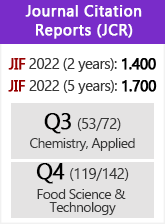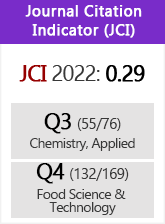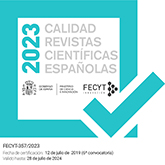Olive fly damage and olive storage effects on paste microflora and virgin olive oil acidity
DOI:
https://doi.org/10.3989/gya.2003.v54.i3.244Keywords:
Bactrocera oleae, Microflora, Oil acidity, Olive fly, Olive storage, Virgin olive oilAbstract
The effects of olive fly damage, olive storage, harvest date, olive grove plot and their interactions on the microflora associated with olive paste and oil acidity were studied. Microflora and oil acidity were significantly affected by the four studied factors and by several interactions between them. Fly damage and olive storage interacted sinergically increasing oil acidity. The relationship between fly damage and oil acidity was lineal although sometimes it was not significant depending on microflora populations. The relationship between microflora populations and oil acidity fitted to a logarithmic model. Major microorganisms in olive paste were bacteria (Xanthomonas), yeasts (mostly Torulopsis and Candida) and in a smaller measure moulds (mainly Fusarium and Penicillium). Results overall suggest that a qualitative damage threshold based on the percentage of damaged fruits in order to infer oil acidity may be unfeasible in most instances.
Downloads
Download data is not yet available.
Downloads
Published
2003-09-30
How to Cite
1.
Torres-Vila LM, Rodríguez-Molina MC, Martínez JA. Olive fly damage and olive storage effects on paste microflora and virgin olive oil acidity. Grasas aceites [Internet]. 2003Sep.30 [cited 2024Apr.17];54(3):285-94. Available from: https://grasasyaceites.revistas.csic.es/index.php/grasasyaceites/article/view/244
Issue
Section
Research
License
Copyright (c) 2003 Consejo Superior de Investigaciones Científicas (CSIC)

This work is licensed under a Creative Commons Attribution 4.0 International License.
© CSIC. Manuscripts published in both the printed and online versions of this Journal are the property of Consejo Superior de Investigaciones Científicas, and quoting this source is a requirement for any partial or full reproduction.All contents of this electronic edition, except where otherwise noted, are distributed under a “Creative Commons Attribution 4.0 International” (CC BY 4.0) License. You may read here the basic information and the legal text of the license. The indication of the CC BY 4.0 License must be expressly stated in this way when necessary.
Self-archiving in repositories, personal webpages or similar, of any version other than the published by the Editor, is not allowed.
















